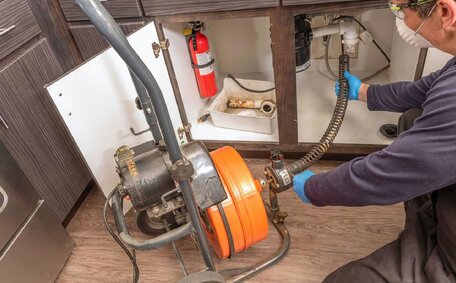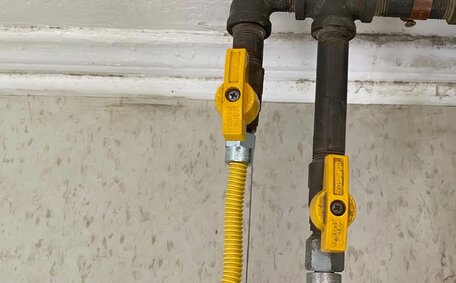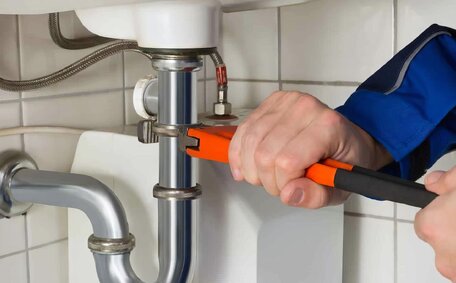Understanding Common Toilet Noises and Their Causes
At Abbotsbury Plumbing, we have over 10 years of expertise diagnosing and resolving common toilet issues. Noisy flushes are a common problem we regularly tackle for homeowners in the Abbotsbury area.
Strange noises emanating from your toilet can be harbingers of underlying plumbing issues:
- When you find your toilet makes noise, particularly a hissing noise, it often indicates a problem with the flapper or flush valve.
- A gurgling sound can suggest a blocked vent stack, likely because gases can’t find their way out of the waste pipes properly.
- The jarring "hammer" noise of water under immense pressure careening through pipes may suggest the need for a hammer arrestor, as such forces can damage your plumbing system over time.
By identifying when the toilet makes noise after certain activities in the bathroom, we can effectively address issues and prevent further damage. Our licensed plumber team, fully-insured and equipped with expertise, can diagnose fix toilet noise issues coming your way and restore full functionality.
Faulty Flapper
A faulty flapper valve is one of the most common causes when your toilet keeps making noise, especially a hissing sound. The flapper is a rubber seal at the bottom of the toilet cistern that lifts, allowing water to rush in after flush is activated. Over time, this seal can become brittle, warped, or simply fail to make a tight seal, allowing water to continuously leak into your toilet bowl.
To inspect your flapper:
- Turn off water supply to your toilet.
- Remove the toilet tank lid and set it aside to address the noises coming your toilet.
- Identify the flapper—it’s the rubber disc ensuring your water is retained at the bottom of the tank attached to the flapper chain.
- Investigate whether the flapper is stiff, misshapen, or cracked and consider 'does my toilet’s flapper correctly seal?' when unusual noises emerge.
- Try lifting the flapper manually; hissing sounds that persist may pose the question of how fix a compromised fill valve seal.
- Check the flapper chain length; essential slack is required so the flapper makes noise but can drop completely over the flush valve.
Replacing a faulty, leaky flapper is a straightforward DIY remedy that prevents wasted water running and excessive noise. We recommend visiting your local hardware store to find a universal-fit replacement flapper, especially if you’re dealing with a foghorn noise emanating from your bathroom fixtures.
Fill Valve Issues
The fill valve toilet component, also known as the inlet valve, is responsible for refilling the toilet tank with fresh water after toilet flushed. When water incorrectly flows into the refill tube instead of the tank or causes the valve not to fully close, it can produce a loud noise.
Over time, a valve can become worn out, misaligned, and cause water flow issues into the toilet tank.
You likely need to adjust or replace your fill valve if you hear hissing that the tank can produce:
- Commences immediately, producing noise when your toilet makes a sound after the completion of its flushing cycle
- Lasts for an extended duration, indicating it makes noise after flushing ceases
- Occurs every few minutes even when no one has flushed recently
The best way to address noise is to try scrubbing the valve seat with steel wool or gently filing the seal area when toilet sounds suggest gunk or buildup.
Make sure the float arm isn’t caught on anything and moves freely. Adjust the water level to prevent it from being the cause your toilet malfunctions by examining the float ball if it’s higher than the recommended position. Make sure the float arm isn’t caught on anything and moves freely.
The first step to installing a new toilet fill valve that ensures smooth water flow into the tank isn’t difficult. Commence by cutting off the toilet’s fill water supply and draining any leftover water.
Disconnect and remove the old valve and clean the opening of any debris when flush maintenance is happening before inserting your new valve. Make sure it’s properly aligned to the correct water your system requires, then turn the water back on and test for leaks and noise.
Incorrect Water Levels
It’s crucial to maintain the proper water level flowing into tank, regularly set about 1 inch below the overflow pipe. If the water level is too high, it can cause a persistent gush into overflow, creating loud noises when the toilet is flushed.
To adjust the water level:
- Shut off the toilet’s water supply.
- Activate the flushing toilet mechanism to empty the tank.
- Check where the water level stabilises after refilling. It should be at least 1 inch below the overflow tube.
- If it’s too high, turn the adjustment screw on the fill valve counterclockwise to lower the level.
Keeping your toilet fill level set properly not only prevents noises but also compels you to sounds watch out for possible water damage from overflow.
Vent or Drain Line Blockages
Gurgling bubbling noises after a toilet flush often indicate a partial blockage in the vent stack or drain line, affecting the normal water flow. The vent stack allows air to enter the waste pipes, consequently reducing noise when use of your plumbing occurs. Draining water may sing its own gurgling tune through your pipes without adequate ventilation.
Employing your plunger can dislodge obstructions, stopping the sound of running water in the toilet. If gurgling continues, this can usually suggest vent problems or a blockage deeper in your drain line. Running a drain snake or making the decision to call plumber would be the next best steps.
Tackling noisy flushes with your own skills is possible, yet A skilled technician should able to precisely locate and address complex issues. Persistent gurgling after multiple attempts with plunges and snakes could signal issues with your main water heater or any other underlying concerns with the main sewer line, especially if tree roots or cracks are instigating recurring drainage troubles.
Diagnosing the Source of the Noise
To diagnose the source of a noisy toilet flush, follow this systematic process:
- For unfamiliar sounds, watch out and consider what they might sound like as you activate the flush. Make careful observations of where sounds originate from and when they occur.
- Open the toilet tank lid and look for reasons why your toilet might be behaving strangely. Visually inspect the condition of parts like the flapper, fill valve, float arm, overflow tube etc.
- Check if you need to turn water off from any of these components to prevent leaks into the toilet bowl, which can cause noises.
- Manually lift the flapper and listen for any hissing to understand why your appliance might be malfunctioning. This indicates a faulty seal.
- Flush again and if the noise persists for too long, consider turning off water while focusing on the fill valve. Listen for any components making noise when flushing, as that is when it should close but doesn’t seal completely.
- Allow the tank to refill and note if water flows into the overflow, signalling incorrect water levels.
By methodically observing where noises come from during different stages of the flush, you can determine if issues relate to toilet water flow or specific parts. This helps narrow down the underlying problem.
If noises persist despite troubleshooting, contact our licenced plumbers. We have the expertise to diagnose and repair noisy toilet flushes.
Adjusting the Flapper and Chain
If you’ve determined a faulty flapper seal is causing noise issues, adjusting the chain is often an easy DIY fix. Follow these steps:
- Begin by disconnecting the flapper chain from the ballcock assembly inside the toilet tank.
- Hold the flapper over the flush valve discharge at the bottom of the tank, ensuring it fully seals the opening.
- With the flapper in the sealed position, connect the chain so there is only 1/4 to 1/2 inch of slack.
- Ensure the chain has just enough length, reflecting on why my toilet may be acting up, thus allowing the flapper to drop completely when flushed.
With a properly adjusted chain, the flapper can now create a tight seal and prevent water from continuously leaking into bowl, thus quieting unwanted noises.
However, adjusting the chain is one most straightforward fixes, if it doesn’t resolve the noise, a flapper replacement might be necessary. Contact our team at Abbotsbury Plumbing to install a new, universal flapper and get your toilet flushing quietly once again.
Replacing a Faulty Fill Valve
If adjusting the fill valve doesn’t resolve the noise issues, replacement is likely needed. Replacing a fill valve is an straightforward job any DIYer can tackle.
Start by asking yourself 'do i need to shut off the water supply’ behind the toilet before flushing to empty the tank. Disconnect and remove the problematic fill valve that might cause your toilet issues, taking note of how components like the float arm are assembled.
You can also clean the valve opening of any gasket fragments or mineral deposits before inserting the new valve. Make sure it’s properly aligned and seated fully into the tank opening.
Reconnect the water line and reassemble other parts, being mindful that leaks can happen at this stage. Turn the water back on and allow the tank to refill, checking for leaks. Adjust the water level, watch out for any irregularities before reattaching the tank lid.
With a brand new fill valve installed, hissing sounds will be eliminated and your toilet can flush quietly once again.
Setting the Right Water Level in the Tank
Having the proper water level in your toilet tank is important to prevent noises, leaks, and other issues. Follow these steps to set the right level:
- Turn the water supply off to ensure safe maintenance operations.
- Flush the toilet to empty out any water in the tank.
- Check where the water level settles after the tank refills. The correct level is 1 inch below the overflow tube.
- If the water is too high, use the adjustment screw on the fill valve counter-clockwise to lower float to the right height.
- Turn the water supply back on and allow the tank to refill. Verify the level is correct.
Ensuring the tank’s water level is properly calibrated prevents relentless flow into the overflow pipe, enabling you to toilet sounds watch out for peculiar echo drain sounds. It also prevents potential leaks and other toilet problems.
Unblocking Vents or Drains
If your attempts at resolving gurgling noises with plunging don’t pan out, you may be dealing with a partial blockage in the vent stack or drain line that necessitates any plumbing expertise for a more thorough unblocking.
Using a Plunger
Start by trying a forceful plunge. Place the plunger over the drain hole to form a tight seal. Pump the plunger up and down vigorously 10-15 times to apply extra pressure to the drainage pipes and attempt to dislodge the clog.
Snaking the Drain
If plunging fails, use a plumber’s drain auger or "snake" to reach deeper blockages. Insert the metal coil into the toilet drain or the main drain line cleanout and twist/rotate the handle while pushing the snake further down the pipes.
Once you hit and dislodge the obstruction, slowly extract the snake while running hot water to help flush away debris.
Seeking Professional Help
Discover more about fixing recurring gurgling noises or vent issues by getting in touch with our licensed technicians at Abbotsbury Plumbing. We have the high-powered equipment and expertise to clear drain obstructions and diagnose vent stack problems.
When to Call a Professional Plumber
Calling a professional plumber is advised when DIY efforts to quiet a noisy toilet are unsuccessful or the issue is complex. Calling a professional plumber is advised when DIY efforts to quiet a noisy toilet are unsuccessful or the issue is complex.
Recurring fill valve hisses or flapper seal leaks causing a running toilet after adjustments indicate a replacement of the faulty components is needed.
Don’t hesitate to give us call at Abbotsbury Plumbing for:
- Old or difficult-to-service toilet models
- Issues within concealed toilet tanks
- Persistent banging noises in your home signalling water hammer, which can lead to significant plumbing problems
- Sewer line repairs from tree root invasion or cracks
With 10+ years of expertise, our licenced technicians have the skills and tools to correctly diagnose and resolve any noisy flush toilet issue. Call 1300 349 338 or email jobs@abbotsburyplumbingservices.com.au to schedule an appointment.






